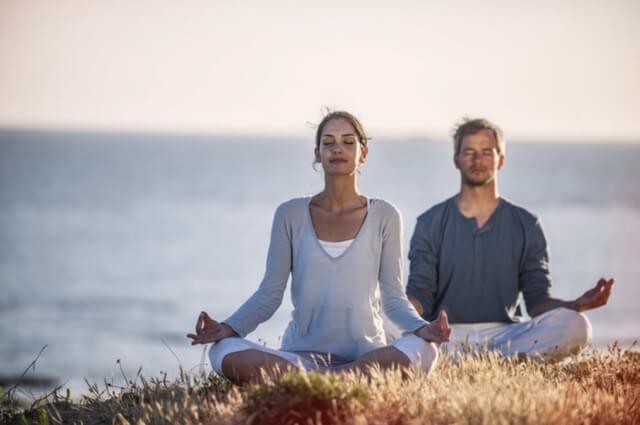Author: Randeep Singh / go to all articles on Yoga cure
Yoga lung exercises for respiration:
After the food we eat is digested – broken down into simpler components – in the digestive system, it is carried to the individual cells where it is required to be converted into energy.
The process of converting the food elements into energy within individual cells is known as – oxidation of the components of the food, this is respiration. Yoga Lung exercises for respiration work on this system of the body.
The process of oxidation consumes oxygen and releases carbon dioxide as a waste product in the cells, thus the body needs to have a system where in it can absorb the atmospheric oxygen (required for converting food into energy) and expel the toxic carbon dioxide as released in the process back into the atmosphere.
Since oxidation is a continuous process – as energy is required all the time by the body systems for their functioning and sustenance – any process for absorbing oxygen from the atmosphere also need to be a perpetual one. Nature has designed the respiratory apparatus for fulfilling this requirement of an incessant supply of oxygen in the body.
Two lungs encased, protected within the rib cage in the thoracic cavity are the main organs of respiratory system wherein the exchange of gases – oxygen is absorbed, carbon dioxide is expelled- between the atmosphere and the body takes place.
The lungs are made out of softer tissues as it need to expand – on being filled with air – and contract – for pushing the air out of it. This contraction and expansion of the lungs is aided by the presence of an open umbrella like dome shaped muscle right under the lungs which is large enough to separate the thoracic cavity from the abdominal cavity.
This sheath like muscle is known as diaphragm the pulsating movement – upwards resembling an open umbrella and downwards resembling a closing umbrella – of which are controlled by autonomic nervous system.
The respiratory apparatus opens to the atmosphere at the nasal cavity, the atmospheric air enters the nasal cavity from where it is directed to the pharynx. From the pharynx the air moves into the trachea – which passes through the throat -or the wind pipe as it is popularly known as.
The trachea branches into two bronchi as it reaches the chest, each bronchi enters into the respective lungs. Each bronchi further divides into narrower tube like structures known as bronchioles. The bronchioles end into sac like structures called alveoli; alveoli contain blood vessels where the exchange of the gases takes place.
The diaphragm moves down into the abdominal cavity which creates space for the lungs to descend, lowering the pressure of the air within the lungs. The atmospheric air is sucked into the lungs from the nostrils as a result of the presence of the difference of pressure of the air between the lungs and the atmosphere. This is known as an inhalation.
The oxygen from the inhaled air is absorbed by the blood in the alveoli, and the carbon dioxide from the same blood is released back into the alveoli. Now the diaphragm moves up squeezing the lungs of their contents back into the atmosphere, this is known as exhalation. One inhalation and one subsequent exhalation is known as one breath.
How Breathe yoga or lung exercises work
Yoga for better respiration and breathing involves yoga asanas which move, stretch and strengthen the muscles of the spine, rib cage and the upper chest which improves the strength of the respiratory apparatus. All the forward bending asanas stretch the intercostal muscles of the back of the rib cage which adds space to the expansion of the lungs.
The more the lungs can expand more is the volume of air that can be taken in per inhalation. The yoga pranayama for better breathing directly work on the respiratory muscles – intercostal, clavicular, diaphragm, abdominal – and enhance their efficiency.

Yoga breathing exercises as lung exercises involve prolonged inhalation and exhalation which strengthens the muscles of respiration which are directly involved in these acts. Regular practice of breathing lung exercises increases the per minute capacity of the lungs to draw in and then process large volumes of which benefit by adding more oxygen to the blood stream.
Correct posture is crucial to the optimal working of the internal organs, any slouch in the spine can compress the rib cage on to the abdomen which reduces the range of expansion of the lungs situated within it.
Yoga asanas for lungs strengthen the muscles of the spine, an erect spine benefits as it facilitates forward expansion of the rib cage which automatically increases the area of function of the lungs. The Yoga for correcting one’s posture helps by keeping the lungs within the rib cage expanded to their full capacity which improves the functioning of the respiratory apparatus.
Backward bending asanas improve the expansion of the chest by adequately stretching the related muscles. Erroneous habits of breathing like keeping the abdomen tight while under distress, keeping the chin low while breathing, and keeping the shoulders rounded while sitting or standing can negatively impact the quality of the breath.
Breathing exercises for healthy lungs when practiced with proper alignment and guidelines makes one aware of these wrong practices and help inculcate healthy breathing practices. Abdominal breathing exercise teaches, habituates one on using the diaphragm properly for a fuller breath.
During our yoga sessions at Shahzadpur Farm Yoga Classes we first train the beginners on the basic lung exercises for preparing the respiratory apparatus for more advanced yoga pranayama for better breathing.
Yoga for better Respiration and Breathing
Other Informative Articles….

